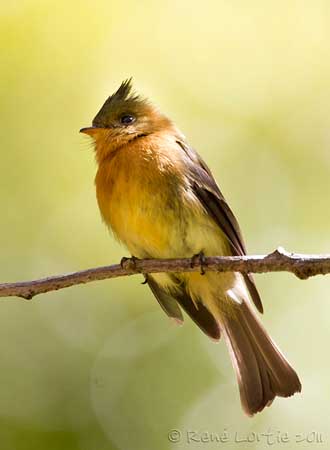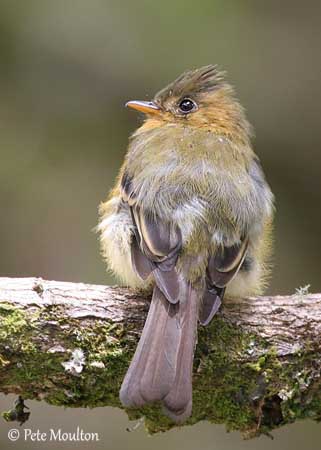
Fr: Moucherolle huppé
All : Gelbbauch-Schnäppertyrann
Esp: Mosquero Moñudo Común
Ital : Pigliamosche dal ciuffo
Nd: Geelbuiktiran
Sd: Tofstyrann
Photographers:
René Lortie
http://rlortie.ca/
Pete Moulton
Pete Moulton Photography
Text by Nicole Bouglouan
Sources:
HANDBOOK OF THE BIRDS OF THE WORLD Vol 9 - by Josep del Hoyo - Andrew Elliot - David Christie - Lynx Edicions - ISBN: 8487334695
A GUIDE TO THE BIRDS OF MEXICO AND NORTHERN CENTRAL AMERICA by Steve N. G. Howell, Sophie Webb - Oxford University Press - ISBN: 0198540124
A GUIDE TO THE BIRDS OF COLOMBIA by Steven L. Hilty and William L. Brown - Princeton University Press – ISBN 069108372X
BIRDS OF SOUTH AMERICA – Passerines - by Robert S. Ridgely and Guy Tudor – HELM Field Guides – ISBN: 9781408113424
BirdLife International (BirdLife International)
Neotropical Birds – Cornell Lab of Ornithology
Wikipedia, the free encyclopaedia
Northern Tufted Flycatcher
Mitrephanes phaeocercus
Passeriforme Order – Tyrannidae Family
INTRODUCTION:
The Northern Tufted Flycatcher belongs to the subfamily Fluvicolinae within the huge Tyrannidae family. This pretty bird often perches in open situations from where it performs sallies near the humid vegetation to catch the prey before to return to the same perch.
This species frequents various forested habitats, and may occur up to 3500 metres of elevation.
DESCRIPTION OF THIS BIRD:
Biometrics:
Length: 12-13 cm
Weight: 8, 5 g
The adult of nominate race has brownish tinged olive upperparts. Wings and tail are dusky. On the upperwing, we can see two buff wingbars and paler edges to secondaries and tertials.
On the underparts, chin, throat and breast are cinnamon to bright ochre, whereas the belly is ochre-yellow.
On the head, the crown is brown tinged olive with pointed crest. Face and head sides are cinnamon, whereas the lower nape is brownish-olive. There are a pale loral spot and a thin buffy-white eyering.
The two-tone bill shows black upper mandible and orange-yellow lower one. The eyes are dark brown. Legs and feet are blackish.
Both sexes are similar.

The juvenile has dark brown crown. Crown and upperparts’ feathers are edged cinnamon-buff. There are two fairly broad cinnamon-orange wingbars.
SUBSPECIES AND RANGE:
The Northern Tufted Flycatcher has four subspecies.
M.p. tenuirostris is found in W Mexico, from Sonora and Chihuahua, S to Jalisco. This race is paler and duller than nominate.
M.p. phaeocercus (here described and displayed) occurs in mountains of E and C Mexico, S to El Salvador and NE Nicaragua.
M.p. aurantiiventris (here displayed too) is found in Costa Rica and Panama. This one resembles nominate race, but with slightly duller upperparts and more ochre than cinnamon underparts.
M.p. berlepschi occurs in extreme E Panama and NW Colombia, S to NW Ecuador. This race has darker crown, yellowish lores, olive back, olive breast with faint ochre wash and bright yellow belly.
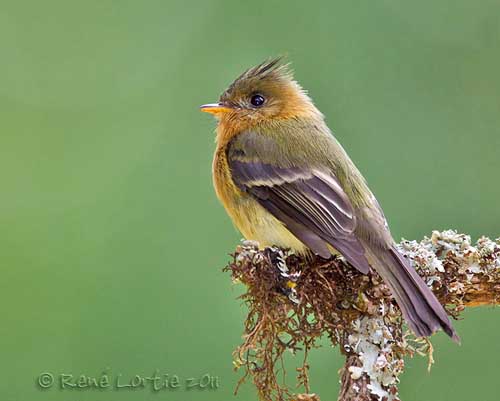
HABITAT:
The Northern Tufted Flycatcher is usually found in humid, wet forest borders, shrubby clearings, treefall gaps and plantations. In winter, it frequents more arid semi-open areas and riparian groves.
This species is visible between 700 and 3500 metres of elevation, mainly at 1200-2150 metres in Costa Rica, and in foothills from 100 to 1200 metres in South America.
CALLS AND SONGS: SOUNDS BY XENO-CANTO
The Northern Tufted Flycatcher often repeats a bubbly series of 4-7 “pik” or “beek” notes while flicking the tail.
The song is a rolled “tchwee-tchwee” or “turree-turree”, less often a single “tchwee”. During the breeding season, it also utters bright, penetrating “seeeu”, “pseeeu” ou “seer”.
In Costa Rica, it sings at dawn, a rapid series of high notes “bip-bip-bip-dididi-up-bip-bip-bibibiseer”.
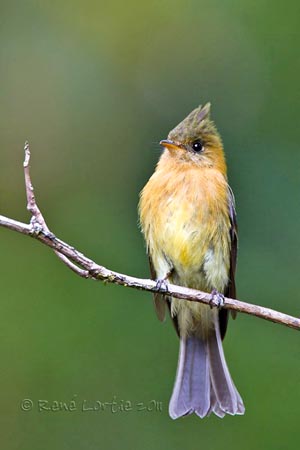
BEHAVIOUR IN THE WILD:
The Northern Tufted Flycatcher feeds mainly on insects. It perches upright on exposed place, at all levels of the forest. It catches the preys by sallying from the perch into the air, and then, it returns to the same perch while flicking the tail when alighting. It may sally several times in quick succession.
It can be seen flycatching actively when hunting, before to return to its perch. It is usually seen alone or in pairs.
The Northern Tufted Flycatcher is monogamous during the breeding season, and the pair defends its territory.
Courtship displays are poorly known, but usually, the flycatchers perform aerial displays accompanied by song. Some posturing, wing-flapping with erect crest and strong calls are part of this behaviour.
Both sexes have similar plumage, and do not perform elaborate displays like sexually dimorphic species are doing.
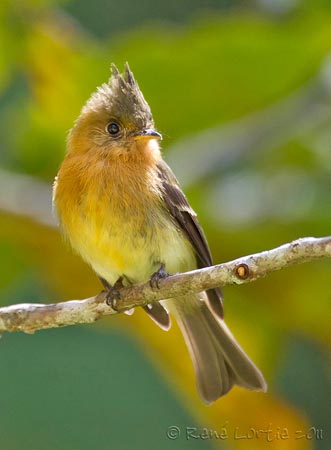
The female takes the most active role during this period, building the nest and incubating alone.
The Northern Tufted Flycatcher is resident in its range, but altitudinal movements occur in some parts of Mexico in winter.
This bird is a good and agile flier. It often hunts by flycatching and aerial-hawking foraging mode. It has great aerial manoeuvrability, very useful when pursuing flying preys. It has long, pointed wing tips.
REPRODUCTION OF THIS SPECIES:
The breeding season takes place in April/June in Costa Rica and in February in Colombia.
The female usually builds the nest, a shallow cup made of dark rootlets, green moss and lichens. It is lined with foliaceous lichens. The nest can be situated between 4 and 27 metres above the ground, in dangling vine or on horizontal branch but hidden in the vegetation.
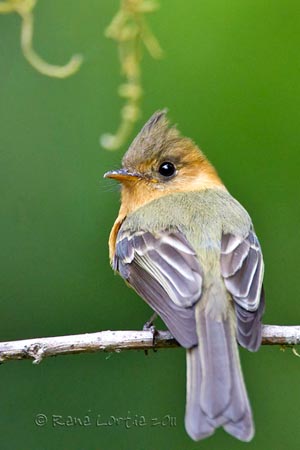
The female lays 2 dull white eggs with brownish blotches. She usually incubates alone, but the male may help in feeding the chicks. The young remain hidden in the vegetation after fledging, and often roost together in a row on a branch.
PROTECTION / THREATS / STATUS:
The Northern Tufted Flycatcher can be relatively common according to the range. This species is not currently threatened.
